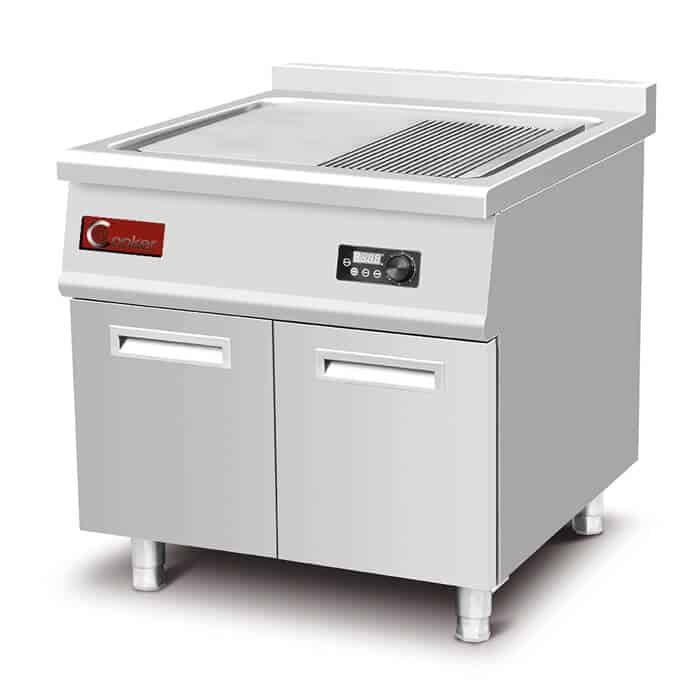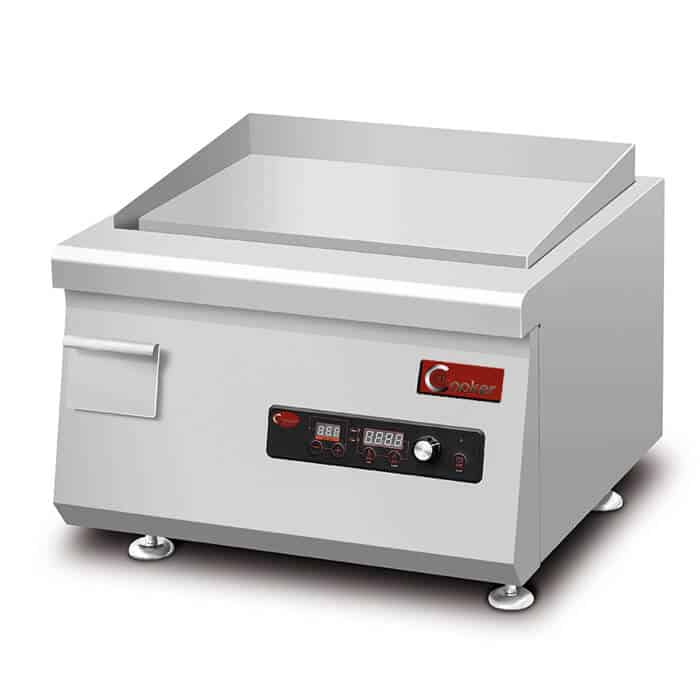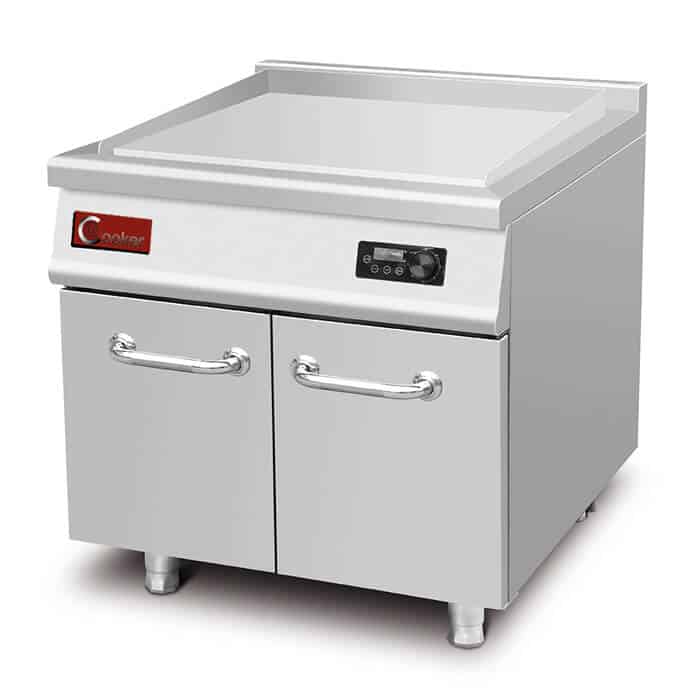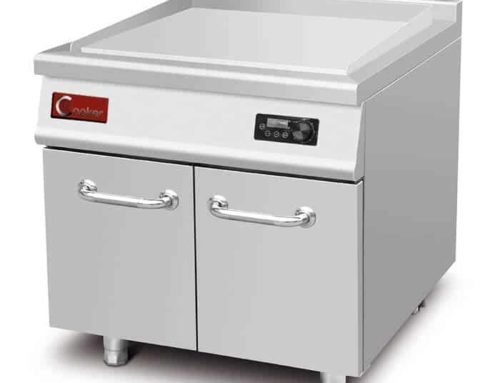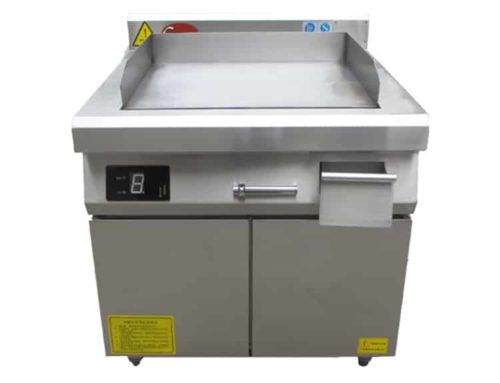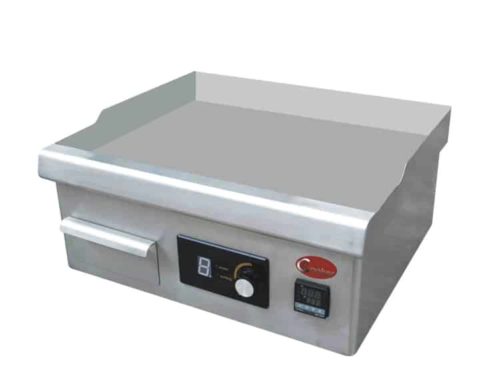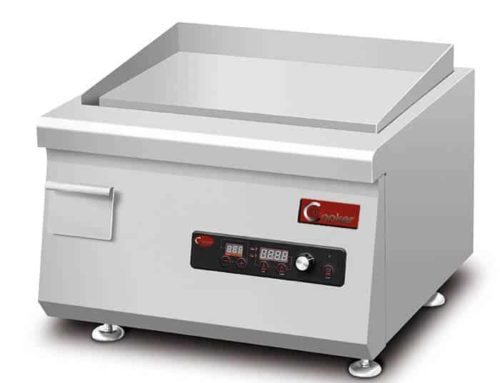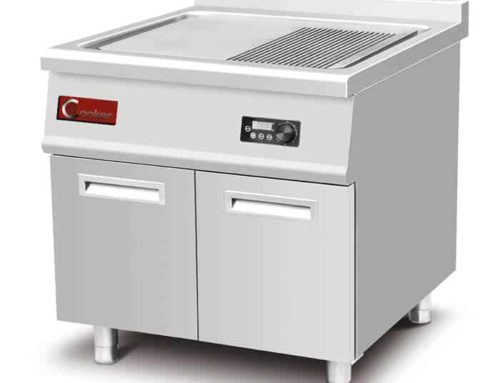How Does the Size of the Griddle Affect Its Performance and Suitability for Different Kitchen Spaces?
The size of a commercial griddle—whether a compact stainless griddle for a food truck or a large electric flat top grill for a hotel kitchen—directly impacts two critical factors: performance (cooking speed, heat distribution, output) and space suitability (fit in tight areas, alignment with workflow). AT Cooker, a leading manufacturer of induction commercial griddles, designs stainless steel models in 12-inch, 24-inch, and 36-inch widths to match diverse kitchen needs. Below, we break down how size influences every aspect of griddle use, with real-world examples from our customers and data from our 3.5KW to 5KW induction griddle lineup.
1. Larger Griddles Provide Greater Cooking Surface Area, Increasing Food Output Capacity
Cooking surface area is the most direct link between griddle size and performance. Larger griddles (24–36 inches wide) offer 2–3x more cooking space than compact models (12–18 inches), allowing kitchens to cook more portions simultaneously—critical for high-volume operations like diners, hotels, or catering companies.
AT Cooker’s 36-inch stainless griddle (model AT-IG36) has a 720 sq. in. cooking surface—enough to cook 24 hash brown portions or 16 burger patties at once. A hotel in Las Vegas uses this model for breakfast buffets: “We serve 300+ guests daily, and the 36-inch griddle lets us cook in bulk. Before, we had two small griddles and still fell behind—now we’re 20% faster.”
Output capacity scales with size:
- 12-inch griddle: 2–3 portions at once (ideal for food trucks, convenience stores).
- 24-inch griddle: 8–12 portions at once (perfect for mid-sized cafes, diners).
- 36-inch griddle: 16–24 portions at once (best for hotels, large restaurants).
2. Smaller Griddles Are Better Suited for Limited Kitchen Spaces or Lower Volume Cooking
Compact griddles (12–18 inches) excel in kitchens where space is at a premium—like food trucks, kiosks, or small cafes. Their narrow design (depth: 14–16 inches) fits on countertops or mobile stations, without sacrificing core functionality.
AT Cooker’s 12-inch griddle for induction cooktop (model AT-IG12) weighs only 25 lbs and fits in standard food truck counter spaces. A food truck operator in Austin said: “My truck’s kitchen is 6 feet wide—this small griddle fits next to my fryer, and I can still move around. It cooks 3 breakfast sandwiches at once, which is perfect for my volume.”
Smaller griddles also shine for “specialty” cooking tasks—like melting cheese for nachos or heating tortillas—where a large surface would be overkill. A convenience store in Seattle uses a 18-inch stainless griddle for hot dog toppings: “We don’t need a big griddle—this one takes up minimal space and does exactly what we need.”
3. Griddle Size Affects Heat Distribution; Larger Surfaces Require More Even Heating Technology
Heat distribution becomes more challenging with larger griddles—hot spots (areas 20–30°F hotter than others) are common in poorly designed large models, leading to unevenly cooked food. To solve this, AT Cooker equips larger stainless griddles with multi-zone induction heating (2–3 independent heating zones) that maintains consistent temperature across the entire surface.
Our 24-inch griddle (AT-IG24) has two 1.75KW heating zones, each adjustable from 200°F to 450°F. A diner in Chicago reported: “We used a cheap 24-inch electric griddle before, and the edges were always 50°F cooler. The AT Cooker model’s zones keep every part of the surface at 350°F—no more burnt or undercooked hash browns.”
Smaller griddles (12–18 inches) have simpler heating systems (single zone) because their compact surface is easier to heat evenly. This makes them more reliable for beginners or kitchens with limited staff training.
| Griddle Size | Heating Technology | Temperature Consistency | Hot Spot Risk | Ideal For |
|---|---|---|---|---|
| 12–18 inches (AT-IG12/IG18) | Single-zone induction | ±2°F | Low (1–2% of surface) | Food trucks, small cafes |
| 24 inches (AT-IG24) | Dual-zone induction | ±3°F | Medium (5% of surface) | Mid-sized diners, cafes |
| 36 inches (AT-IG36) | Triple-zone induction | ±4°F | Low (3% of surface) | Hotels, large restaurants |
| 48 inches (AT-IG48) | Quad-zone induction | ±5°F | Medium (7% of surface) | Catering, stadiums |
4. Compact Griddles Heat Up Faster Due to Smaller Surface Area
Heating time is inversely related to griddle size: smaller surfaces require less energy to reach cooking temperature (350°F), making them faster to start and more flexible for quick-service needs.
AT Cooker’s 12-inch griddle heats to 350°F in 3 minutes, while the 36-inch model takes 7 minutes. A coffee shop in Denver uses the 12-inch model for morning breakfast sandwiches: “We open at 6 AM, and the griddle is ready to use by 6:03. With our old large griddle, we had to preheat at 5:45—wasting 15 minutes of energy.”
Faster heat-up also reduces idle energy use. A food truck that only operates for 4 hours daily saves 0.5 kWh/day by using a small griddle (3-minute preheat vs. 7-minute preheat)—adding up to $27/year in savings.
12-Inch Griddle (AT-IG12)
Time to reach 350°F
24-Inch Griddle (AT-IG24)
Time to reach 350°F
36-Inch Griddle (AT-IG36)
Time to reach 350°F
5. Large Griddles May Consume More Energy, Impacting Operational Costs
Energy consumption scales with griddle size—larger models need more power to heat their surface and maintain temperature. AT Cooker’s 12-inch griddle uses 3.5KW, while the 36-inch model uses 5KW—43% more energy. For kitchens using griddles 8 hours daily ($0.15/kWh), this translates to:
- 12-inch griddle: 3.5KW × 8h × $0.15/kWh = $4.20/day = $126/month.
- 24-inch griddle: 4.2KW × 8h × $0.15/kWh = $5.04/day = $151.20/month.
- 36-inch griddle: 5KW × 8h × $0.15/kWh = $6.00/day = $180/month.
However, larger griddles often reduce energy use per portion. The 36-inch model cooks 24 portions at once (vs. 3 for the 12-inch), so energy per portion is $0.25 (vs. $1.40 for the small griddle). A hotel kitchen noted: “Our monthly energy bill is higher with the large griddle, but we cook 8x more portions—our cost per meal dropped by 75%.”
— Maria, Diner Owner (Chicago, IL)
6. Stainless Steel Griddles Offer Durability and Ease of Cleaning Regardless of Size
All AT Cooker griddles use 304# stainless steel for their cooking surfaces and bodies— a material that resists rust, scratches, and staining, regardless of size. This durability is critical for commercial use, where griddles are scrubbed daily and exposed to spills.
Cleaning ease doesn’t vary with size: stainless steel surfaces wipe clean with a damp cloth and mild detergent, and AT Cooker’s “no-stick induction surface” (polished to reduce food adhesion) works for all models. A catering company in Miami uses both 12-inch and 36-inch stainless griddles: “Cleaning either takes 5 minutes—no difference in effort. The stainless steel doesn’t stain, even with tomato sauce or grease.”
Stainless steel also retains its appearance over time. A 36-inch griddle in a Seattle restaurant has been in use for 3 years: “It still looks like new—we get compliments from health inspectors on how clean it is. Our old electric griddle started rusting after 6 months.”
7. Size Influences the Number of Burners or Heating Zones Available
The number of heating zones (or burners, for gas griddles) increases with griddle size, giving kitchens more control over temperature for different foods. Small griddles (12–18 inches) have 1 zone, while large models (36+ inches) have 3–4 zones—allowing simultaneous cooking of items with different temperature needs.
AT Cooker’s 36-inch griddle has 3 zones: “We set one zone to 200°F for keeping eggs warm, one to 350°F for hash browns, and one to 400°F for searing bacon,” said a hotel chef in Las Vegas. “With our old single-zone griddle, we had to cook in batches—now we do it all at once.”
Zones also reduce energy waste: you can turn off unused zones on large griddles during slow periods. A diner uses only 1 zone of their 24-inch griddle during afternoon lulls, cutting energy use by 50%.
8. Large Griddles May Require More Ventilation and Space for Installation
Large griddles (24+ inches) need more space for installation and ventilation—critical factors for kitchen layout planning:
- Counter space: 36-inch griddles need 40+ inches of counter length (including 2–3 inches of clearance on each side).
- Ventilation: Gas griddles need hoods with 200+ CFM (vs. 150 CFM for small models); induction griddles need minimal ventilation but still require 6–8 inches of overhead clearance.
- Electrical capacity: 5KW large induction griddles need 240V/20A dedicated circuits (vs. 15A for small models).
A restaurant in New York learned this during renovation: “We bought a 36-inch griddle without measuring—our counter was only 30 inches long. We had to rebuild the counter, adding $1,000 to our budget.” AT Cooker provides free layout consultations to avoid such issues: “Their team told us our 24-inch counter could only fit an 18-inch griddle—saving us from a costly mistake,” said a café owner.
9. Smaller Griddles Offer Greater Portability and Flexibility in Kitchen Layout
Compact griddles (12–18 inches, 20–30 lbs) are portable, making them ideal for mobile kitchens or flexible layouts. They can be moved between countertops, stored when not in use, or even used outdoors for events.
AT Cooker’s 12-inch griddle has a built-in handle and weighs 25 lbs—easy for one person to carry. A catering company uses it for outdoor weddings: “We load it in the van, set it up on a folding table, and plug it into a generator. It’s way more flexible than a large griddle, which would need a truck and dedicated power.”
Portability also helps with deep cleaning: small griddles can be moved to access hard-to-reach counter areas, while large models are fixed in place—requiring more effort to clean around.
Portability Comparison: Small vs. Large Griddles
- Small Griddles (12–18 inches):
- Weight: 20–30 lbs (one-person carry).
- Power: 120V or 240V (works with generators).
- Storage: Fits in cabinets or under counters.
- Large Griddles (24–36 inches):
- Weight: 50–80 lbs (two-person carry).
- Power: 240V dedicated circuit (no generator use).
- Storage: Fixed installation (cannot be moved).
10. Griddle Size Should Match Kitchen Workflow to Optimize Efficiency
Griddle size must align with how your kitchen operates—e.g., a “line cooking” workflow (stations for different tasks) needs smaller, dedicated griddles, while a “batch cooking” workflow (large quantities at once) needs a single large griddle.
A fast-casual burger joint uses two 18-inch griddles in their line: one for patties, one for buns. “Separate griddles keep the line moving—cooks don’t have to wait for space,” said the manager. A hospital cafeteria, however, uses one 36-inch griddle for batch-cooking 200+ meals at once—more efficient than multiple small griddles.
11. Oversized Griddles May Lead to Underutilization and Wasted Energy
Choosing a griddle larger than needed leads to two key issues: underutilization (wasted space) and energy waste. A small café with a 36-inch griddle uses only 20% of the surface daily—wasting 80% of the griddle’s capacity and 40% of its energy (since the entire surface still heats up).
AT Cooker’s customer surveys show that 30% of kitchens with oversized griddles regret their choice: “We bought a 24-inch griddle for our café, but we only cook 4 portions at once. It’s a waste of space and money—we should have gotten an 18-inch model,” said a café owner in Portland.
12. Proper Sizing Ensures Consistent Cooking Performance and Food Quality
An improperly sized griddle compromises food quality:
- Undersized griddles: Overcrowding leads to uneven cooking (food steams instead of searing) and longer wait times.
- Oversized griddles: Hot spots form on unused surface areas, and food may cool before serving if not moved to a smaller zone.
A fast-food chain standardized on 24-inch griddles after testing: “Undersized griddles led to 15% of burgers being undercooked; oversized ones caused 10% of fries to cool. The 24-inch model hits the sweet spot—consistent quality and no waste.”
13. Choosing the Right Griddle Size Balances Kitchen Capacity, Menu Needs, and Energy Use
The best griddle size is a balance of three factors:
- Kitchen capacity: Measure available counter space and electrical/ventilation capacity.
- Menu needs: Calculate peak portion output (e.g., 50 portions/hour = 24-inch griddle).
- Energy use: Avoid oversized models that waste power; choose multi-zone large models to reduce idle energy.
AT Cooker’s stainless griddles—from 12-inch compact to 48-inch industrial—are designed to fit every need. Our team provides free size assessments: share your kitchen dimensions and menu volume, and we’ll recommend the perfect model. Whether you need a griddle for induction cooktop or a large electric griddle, proper sizing ensures you get the most from your investment.
Get a Custom Griddle Size Recommendation for Your Kitchen
Share your kitchen space, menu volume, and workflow—we’ll help you choose the perfect stainless griddle size.
